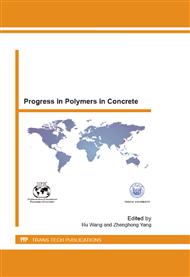[1]
Y. Ohama, Polymer-based admixture, Cement and Concrete Composites. 20(1998) 189-212.
Google Scholar
[2]
S.Y. Zhong, Z. Chen, Properties of latex blends and its modified cement mortars, Cem. Concr. Res. 32(2002) 1515-1524.
DOI: 10.1016/s0008-8846(02)00813-x
Google Scholar
[3]
J. Mirza, M.S. Mirza, R. Lapointe, Laboratory and field performance of polymer-modified cement-based repair mortars in cold climates, Constr. Build. Mater. 16(2002) 365-374.
DOI: 10.1016/s0950-0618(02)00027-2
Google Scholar
[4]
R.Wang, P.M. Wang. The influence of SBR powder on the generation process of cement hydration products, China Ceramic Society (in Chinese). 36(2008) 0912-0919.
Google Scholar
[5]
R. Wang, P.M. Wang, Formation of hydrates of calcium aluminates in cement pastes with different dosages of SBR powder, Constr. Build. Mater. 25(2011) 736-741.
DOI: 10.1016/j.conbuildmat.2010.07.013
Google Scholar
[6]
S.Zeng, N.R. Short, C.L. Page, Early-age hydration kinetics of polymer-modified cement, Advances in Cement Research. 8(1996) 1-9.
DOI: 10.1680/adcr.1996.8.29.1
Google Scholar
[7]
R.Wang, X.G. Li, P.M. Wang, Influence of polymer on cement hydration in SBR-modified cement pastes, Cem. Concr. Res. 36(2006) 1744-1751.
DOI: 10.1016/j.cemconres.2006.05.020
Google Scholar
[8]
D.A. Silva, P.J.M. Monteiro, Analysis of C3A hydration using soft X-ray transmission microscopy: effect of EVA copolymer, Cem. Concr. Res. 35(2005) 2026-2032.
DOI: 10.1016/j.cemconres.2005.02.002
Google Scholar
[9]
Ł. Kotwica, J.Małolepszy, Chemical aspects of EVA redispersible powders influence on the hydration of tricalcium aluminate, in: Á. Palomo, A. Zaragoza, J.C.L. Agüí, Cementing a Sustainable Future XIII ICCC International Congress on the Chemistry of Cement, Editado por el Instituto de Ciencias de la Construcción "Eduardo Torroja", Madrid, 2011.
DOI: 10.21041/conpat2019/v1cc290cte
Google Scholar
[10]
J. Pourchez, P. Grosseau, B. Ruot, Current understanding of cellulose ethers impact on the hydration of C3A and C3A–sulphate systems, Cem. Concr. Res. 39(2009) 664-669.
DOI: 10.1016/j.cemconres.2009.05.009
Google Scholar
[11]
D.A. Silva, P.J.M. Monteiro, Hydration evolution of C3S–EVA composite analyzed by soft X-ray microscopy, Cem. Concr. Res. 35(2005) 351-357.
DOI: 10.1016/j.cemconres.2004.05.049
Google Scholar
[12]
D.A. Silva, P.J.M. Monteiro, The influence of polymers on the hydration of portland cement phases analyzed by soft X-ray transmission microscopy, Cem. Concr. Res. 36(2006) 1501-1507.
DOI: 10.1016/j.cemconres.2006.05.010
Google Scholar


